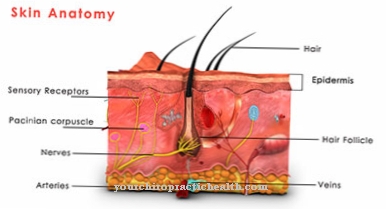Lichen sclerosus is a rare disease of the skin with inflammation-related changes in the connective tissue, the cause of which is suspected to be a dysregulation of the immune system. Women are generally 5 to 10 times more likely to be affected by lichen sclerosus than men.
What is lichen sclerosus?

© Designincolor - stock.adobe.com
As Lichen sclerosus is a rare chronic inflammatory connective tissue disease, which is probably due to a dysregulation of the immune system (autoimmune disease).
Lichen sclerosus usually manifests itself in the genital area, more rarely in extragenital areas such as hands, arms or on the back (about 10-15%). While in women mainly the labia (labia), clitoris, clitoral hood and the perianal area (region around the anus) are affected, lichen sclerosus manifests itself in men on the foreskin (preputium), glans (glans penis) and only occasionally in the perianal region .
Lichen sclerosus is characterized by porcelain-like, white skin discoloration with reactive thickening of the epidermis (cornification), which is caused by sclerosis (inflammation-related increase) of the connective tissue below.
As a result of the sclerotic atrophy (tissue thinning) of the affected skin areas, phimosis (narrowing of the foreskin) can develop in men and shrinkage of the labia or clitoris in women, which leads to pain during sexual intercourse. Pruritus (itching), urethral strictures with painful urination, and vaginal stenosis are other possible symptoms of lichen sclerosus.
causes
The etiology of the Lichen sclerosus is largely unclear so far. A multifactorial genesis of the disease is assumed in the presence of a genetic predisposition, although no familial clusters can be observed.
Lichen sclerosus can most likely be traced back to a dysregulation of the immune system (autoimmune disease). In the course of several studies, a reactivity to ECM1, an extracellular matrix protein, could be demonstrated in the majority of those affected. It is not yet known which factors trigger these dysregulated processes. Trauma (including sexual abuse, scratching) are considered possible trigger factors.
In addition, in almost 30 percent of cases, lichen sclerosus is associated with other autoimmune diseases such as Hashimoto's thyroiditis, type 1 diabetes mellitus, asthma, lupus erythematosus, autoimmune gastritis, circular hair loss (alopecia areata) and vitiligo (white spot disease). Borrelia (bacteria that cause borreliosis) are also discussed as a cause of disease for lichen sclerosus.
Symptoms, ailments & signs
Lichen sclerosus is usually noticeable in the adolescents and adults affected by intermittent itching or burning and stinging in the genital area. In addition, changes in the skin can occur that initially resemble a fungal infection. Problems with sexual intercourse, especially with penetration, are also characteristic.
In some women, after sexual intercourse, a strong feeling of sores develops in the genital area. This can last for a few days and be associated with bladder problems, pain and inflammation. In men, white, slimy coatings form in the area of the penis that have an unpleasant smell.
Painful skin changes can form, which first appear on the foreskin and then spread to the glans and the entire penis. In children, lichen sclerosus manifests itself as a symmetrical reddening of the genitals. The symptoms of the disease usually appear very suddenly and increase in intensity as the disease progresses.
Eventually, severe pain and noticeable changes to the skin appear. If lichen sclerosus is treated early, the symptoms usually subside after a few days to weeks. If insufficient therapy is given, ulcers and scars can develop in the affected area.
Diagnosis & course
An initial suspicion Lichen sclerosus Usually results from the characteristic symptoms (especially the porcelain-like, white skin scarring) and a gynecological examination with the colposcope (microscope to check the vagina and cervix).
The diagnosis is confirmed by a biopsy (sampling from the affected skin area with the punch cylinder) followed by a histological (tissue) analysis. The histological finding also serves to exclude malignant degeneration and to differentiate lichen sclerosus from partially comparable diseases such as genital mycosis or circumscribed scleroderma (also morphea).
As a chronic disease, lichen sclerosus is classified as incurable and occurs in phases, with symptom-free intervals between the attacks. If left untreated, lichen sclerosus leads to atrophy, chronic itching and synechiae (adhesion of tissue layers) to degeneration of the affected skin areas.
Complications
As a result of this disease, patients suffer from various ailments, all of which are very unpleasant and can lead to a reduced quality of life. Those affected suffer from itching and itchy wounds. Wound healing is also delayed by this disease, so that infections or inflammations can occur more often.
It is also not uncommon for pain to occur when urinating. These are burning and often lead to psychological problems or depression. It is also not uncommon for bleeding to occur on the skin. In men, the disease can also cause problems in the genitals and especially in the foreskin. This can also lead to restrictions in sexual intercourse.
Treatment of this disease is usually carried out with the help of drugs. Complications usually do not occur and the disease progresses positively. The treatment does not reduce the risk of a new outbreak of the disease. The life expectancy of the person affected is not reduced. The affected person also has to forego various care products in order to stabilize the skin in the affected areas.
When should you go to the doctor?
In most cases, abnormalities in the genital area are an indication of an existing disease. A visit to the doctor is advisable if the symptoms persist for several days or weeks. If the symptoms increase in intensity or if they spread further, you should see a doctor immediately. A doctor is needed if there is pain or a burning sensation on the skin. Consult a doctor if itching or open wounds occur. Pathogens and germs can enter the organism through the open wounds and trigger further diseases.
In severe cases there is a risk of blood poisoning and thus a life-threatening condition. A visit to the doctor is therefore advisable in the event of pus, fever or general malaise. If a feeling of soreness develops after intercourse, this should be observed. In the case of slimy coverings or an unpleasant body odor in the genital area, a doctor's visit is required. Reddening of the skin, swelling or bleeding should be examined and treated. If women experience irregular menstrual cycles, they should consult a doctor. If men or women develop sexual dysfunction, a doctor should be consulted. Likewise when a man perceives changes in the foreskin. If ulcers or scars develop, the observations should be discussed with a doctor.
Treatment & Therapy
The therapeutic measures are aimed at one Lichen sclerosus especially to relieve the symptoms. As a rule, highly potent topically applied corticosteroids (including clobetasol propionate) are used as part of shock therapy with high initial doses.
Another therapeutic option is treatment with calcineurin antagonists such as pimecrolimus or tacrolimus for immunosuppression.Although advanced atrophy cannot be reversed by the drugs mentioned, the progression of the disease is slowed down and, in the best case, stopped. While the previously assumed effectiveness of testosterone has not been proven, topical progesterone treatments for lichen sclerosus are being tested in clinical studies.
In addition, fatty creams (water-in-oil creams), ointments or oils are recommended for additional care of the affected skin areas and stabilization of the skin barrier while avoiding irritating shower lotions, soaps or perfumes. If there are also infectious diseases, these should be treated appropriately with anti-infectives (e.g. with antimycotics or antibiotics).
While in women the inflammatory processes can only be controlled and restricted and today, due to the high rate of recurrence, surgical measures such as vulvectomy or skin grafts are dispensed with, circumcision (circumcision) is used in most cases in men with lichen sclerosus and phimosis. through which the disease can often be stopped.
Outlook & forecast
Lichen sclerosus is a chronic disease - especially in girls and women - which in most cases cannot be cured. As a result, it lasts for life and only the typical symptoms of the disease can be alleviated with a well-adjusted therapy. The earlier treatment is started, the easier it is to control the disease. If lichen sclerosus is diagnosed late, the therapy proves to be more difficult, because in most cases complications such as internal adhesions have already occurred. Up to now, no cure is possible, especially in adult women. Both boys and men can be cured by circumcision.
Basically, lichen sclerosus is a benign disease. Nevertheless, the risk of developing skin cancer is increased. For this reason alone, those affected should visit the dermatologist regularly in order to identify and treat malignant changes in the skin at an early stage.
The current therapy options do not have the same effect on all patients, which is why the general level of suffering is very individual from patient to patient. Careful care of the affected skin areas during and outside of the relapses is very important for a favorable prognosis.
prevention
Since the causes and trigger factors for Lichen sclerosus have not yet been clarified, the disease cannot be prevented. However, certain forms of lichen sclerosus (including the hyperplastic variant) are considered non-infection-associated risk factors for malignant degeneration (squamous cell carcinoma), which is why those affected, especially women, should have regular medical examinations.
Aftercare
The follow-up measures for skin diseases usually depend very much on the exact disease, so that generally no general prediction can be made. The same applies to the disease lichen sclerosus: The earlier this disease is recognized and treated by a doctor, the better the further course, which is why the person affected should consult a doctor at the first symptoms and signs.
Aftercare focuses on strengthening the weakened immune system and thus promoting the recovery process. Relaxation exercises can help, as can avoiding stress. A high standard of hygiene can have a positive effect on the course of such diseases. In most cases, treatment is done through the use of creams or ointments and through taking medication.
The person affected should ensure regular use and the correct dosage in order to permanently alleviate the symptoms. Regular checks by a doctor are very important.
You can do that yourself
When treating lichen sclerorus, the focus is on alleviating the symptoms. In addition to various medications, conservative resources from the household and nature as well as some self-help measures are used.
The most important measure is to prevent seizures. This is achieved by recognizing possible causes and triggers and avoiding them. Changing your diet is particularly important. Patients should speak to a specialist about this and also seek advice from other affected persons. This allows you to quickly determine which individual triggers are present. Overall, people with lichen sclerosus should lead a healthy lifestyle. Regular exercise, adequate sleep, avoidance of stress and other measures that strengthen the immune system can significantly reduce the symptoms of this rare skin disease.
Since certain forms of lichen sclerosus carry an increased risk of cancer, those affected should have regular medical examinations. It is advisable to consult a specialist at an early stage and work out a suitable therapy together with him. In addition, the measures mentioned must be carried out regularly in order to avoid an attack and the associated symptoms.



.jpg)
.jpg)



















.jpg)



